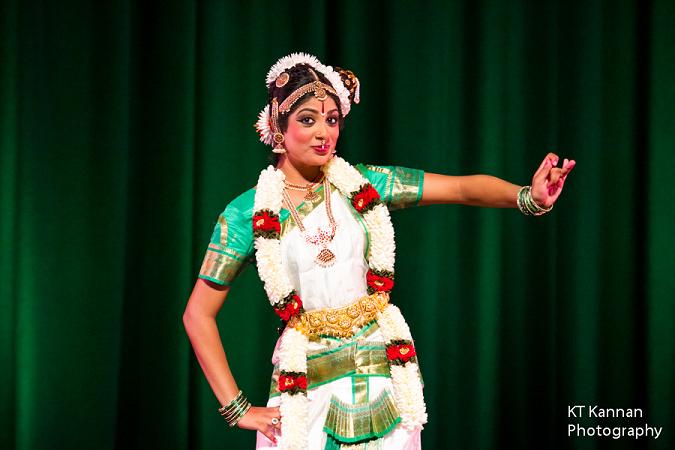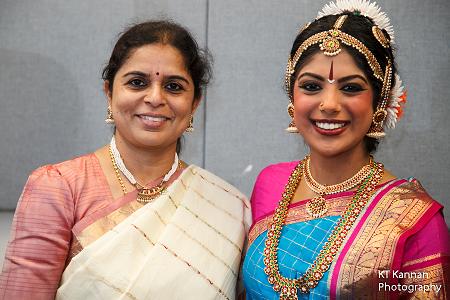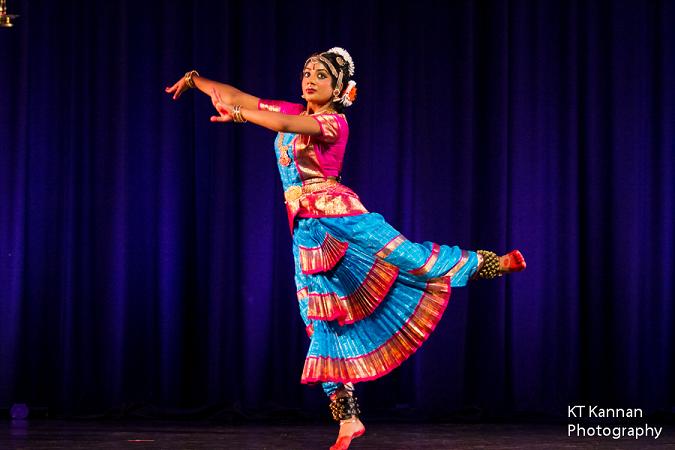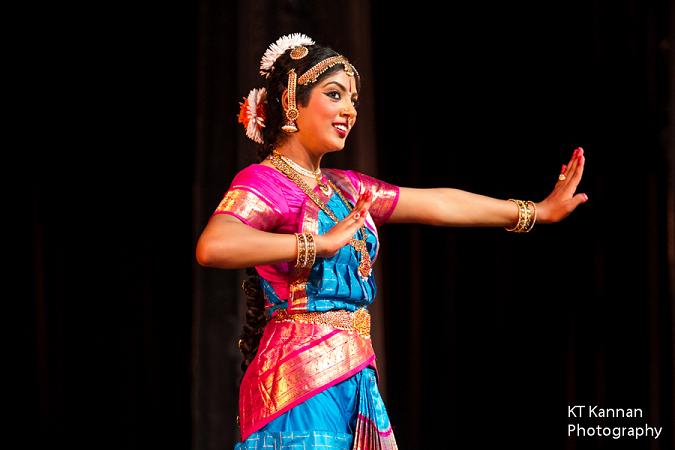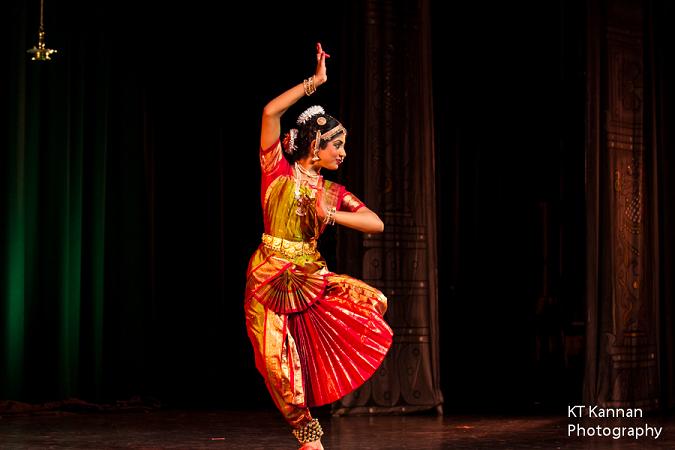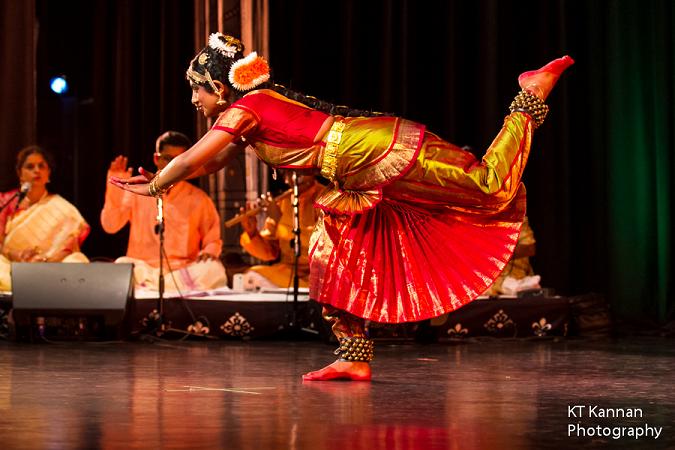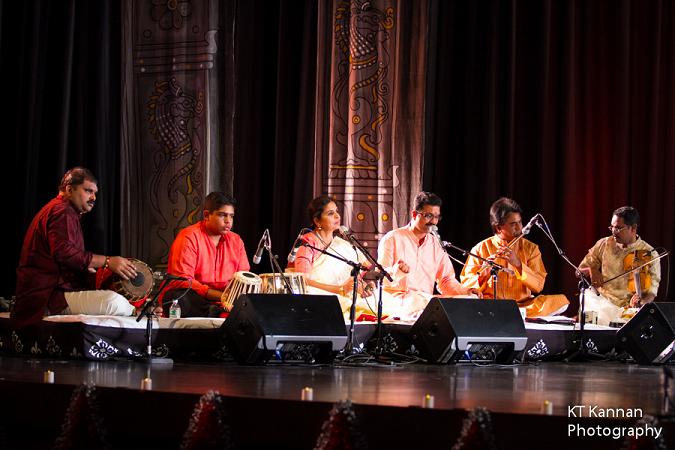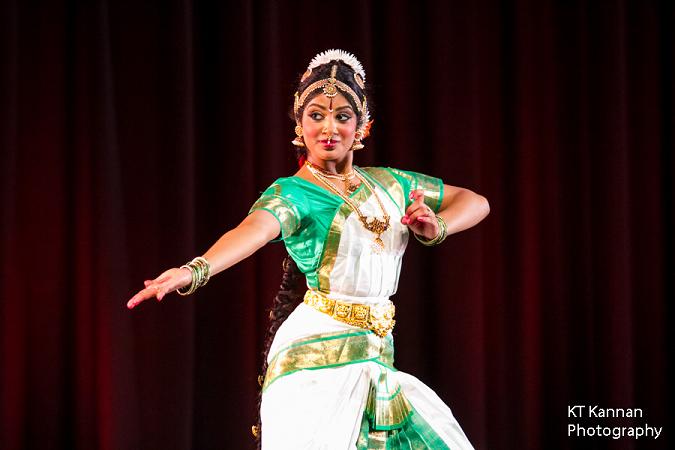Contribute
| Arangetram: Shilpa Narayanan |
S.Ramamoorthy
08/27/2013
Sweet sixteen! A critical age for a teenager to win over several distractions and follow the inner urge that motivates to achieve great. Shilpa Narayanan is quite blessed in this that she could score a 'double'. With a remarkable academic career at the Westford Academy in her Junior year, she embarked her journey into performing her Bharatanatya arangetram (debut public performance). The special day was August 11th, 2013 at the panoramic Performing Arts Center in Littleton, MA
Shilpa came under the tutelage of the illustrious Guru, Smt. Jeyanthi Ghatraju about six years ago. As she progressed through the years, she evinced immense interest and passion in the pursuit of dance leading up to her arangetram.
The format for an arangetram, Margam, from pushpanjali to thillana, as given by the Thanjavur quartet, is thoughtfully designed to elevate the experience gradually from merely visual movement to the acme of touching one’s innate divinity. The curtain raiser item was Siddhivinayakam anusham melodiously presented by the orchestra. Shilpa commenced her arangetram elegantly with an invocation consisting of nritha vandanam and a short verse by K.Lalitha in ragam Bhoopalam followed by Pranavakaram Siddhivinayakam, a composition of Oothukadu Venkatakavi in ragam Arabhi.
Alarippu followed next, in assertive Khanda nadai of five counts. In these days of many dancers doing away with alarippu, it was pleasing that the guru and sishya kept up the tradition; alarippu supposedly symbolizes awakening of the body and mind, and is the first lesson in applying basic nritha.
Shilpa moved on to portray the enchanting features of Lord of dance, Shiva in the virutham, Viriththa Senjadai Aada, by the legendary musician, Musiri Subramania Iyer. Incidentally it became a rejoicing recap for the elderly audience to hear this song from the nineteen forties.
Shilpa delightfully dwelled on the cosmic dance of the Lord, in Mahadeva kavuthuvam, a composition of Madurai Krishna Iyengar in ragam Mohanam, set to Adi talam.
Shilpa’s jathiswaram was a time-tested piece and set to Thodi ragam, and Roopaka talam. She did full justice to the composition and performed with grace. A musical interlude ensued and the reputed musicians entertained the audience with their soul-filling rendition of songs like Vanamali Radharamana.
The evening's Varnam was 'Devaki Nandana, one of the master pieces of Saint Madhvacharya, describing the ten incarnations (Dashavataram) of Lord Vishnu. With her fine display of thundering emotions and vibrant movements, Shilpa enthralled the audience. Her delicate poses to decipher each incarnation and message from each incarnation reflecting emphatic story telling drew lusty cheers from the audience. Shilpa’s portrayal of the scenic beauty of Lord Narayana's cosmic forms, from the fish, Matsya to anguished Narasimha, to a majestic and ideal warrior, Rama and the ever-delightful Krishna proclaiming the Bhagavad Gita were all watched in rapt attention. The stellar choreography included apt slokams from the Bhagavad Gita which made for a blissful experience. Notwithstanding an underlying revelation in Dashavataram is that it strikes a parallel to the evolution theory of Charles Darwin, as the incarnation starts from a harmless fish (matsya avatar) going through biological transformations to amphibians, a half man-half beast to the highly evolved human beings with high ideals.
After a brief intermission, Shilpa explored the expressional aspects of bharatanatyam in a couple of padams. In Yaarukkum adangaadha Neeli, composed by Harikesavanallur Muthiah Bhagavathar, Shilpa portrayed emphatically goddess Durga, who combatted the dangerous demon Mahishasura. It was pure delight to watch Shilpa dancing to the chanting of Mahishasura Mardini stothram in the background; in the exuberance of joy, the audience too joined the chanting.
The next padam was Brahmam Okate, composed by Saint Annamacharya who spells out a clarion call for communal amity. Shilpa extended this eloquent call of the composer through thumping movements and effervescent expressions.
Thillana, the concluding number in an arangetram, brings out the joy to the performer and the perceiver. Shilpa's thillana happened to be a salutary tribute to the composer, legendary violin maestro (Late) Lalgudi Jayaraman The thillana was in the joyous raga combo Mohanakalyani set to a fast pace. Shilpa displayed the joy with consummate elegance, embellished and graceful swift twists and turns, a proud testimony to the dancer's mastery of the divine art.
As a welcome change from the routine, Shilpa presented her Mangalam encompassing Nachiar Thirumozhi, composed by the Saint Andal. Varanam Ayiram in Ragamalika and Adi talam describes the dream wedding of Andal with Lord Narayana, symbolizing the union of the soul with the divine supreme. Through her enthralling enactment and expressions, an ecstatic Shilpa brought this audience-friendly program to a thrilling finish. A solemn atmosphere prevailed before the audience burst into cheers congratulating Shilpa. As a happy coincidence, Shilpa's father, Narayanan offered a verbal garland (Paamaalai) in praise of his daughter's prestigious achievement
Shilpa must feel fortunate to have come under the tutelage of ever-caring guru Jeyanthi Ghatraju. The guru is an untiring dancer and choreographer; she is quite unassuming and deep in her choreography and presentations. Her teaching methods are most human, not sacrificing the values at any time. She bestows amazing attention in structuring the dance programs and methodically preparing her students. Her unbound dedication to utilize this art for charity gives a new dimension to the art, winning her many accolades. The sishya followed her guru in that she decided to donate all her gifts from the arangetram to worthy causes such as SAHELI and the Hindu Temple of New Hampshire.
Guru Jeyanthi must have worked diligently with the orchestra that the whole team provided a pillar of support to Shilpa throughout the program. Vocalist Prasanth Parasini’s golden voice reverberated in the auditorium and in our hearts for a long time; Mridhangist Dhananjayan provided unobstructed and able rhythmic accompaniment; Violinist Muruganandan and Flautist Suryanarayanan were quite the pair in engaging with the dancer throughout and embellishing the sancharis, playing their role with adept skills. Each is an expert in their own area, blended together synergistically and contributed richly, enhancing the experience for Shilpa and the audience. A surprise inclusion to this ensemble was Pranav Ghatraju on tabla. He mingled in quite amicably as a contributing percussionist and was loudly cheered by the audience.
A word of message to Shilpa as an arangetram take-away! To have had all the right elements together in pursuing this art form and doing an arangetram is a blessing in itself. It is equally important to continue on with the same passion and vigor to reach greater heights and for a long and fruitful artistic journey.
After all it is a Herculean task to organize an arangetram .Precise planning and proper execution mustering manual and material resources are vital and the happy ending brings the feeling of “Mission Accomplished!†This was largely visible on the gleeful faces of the Narayanan couple, who gratefully acknowledged the long list of family, friends and well-wishers for their unconditional support.
You may also access this article through our web-site http://www.lokvani.com/
